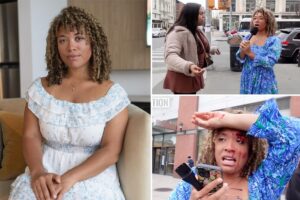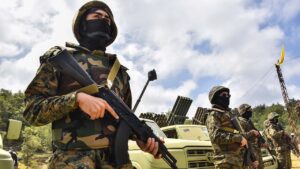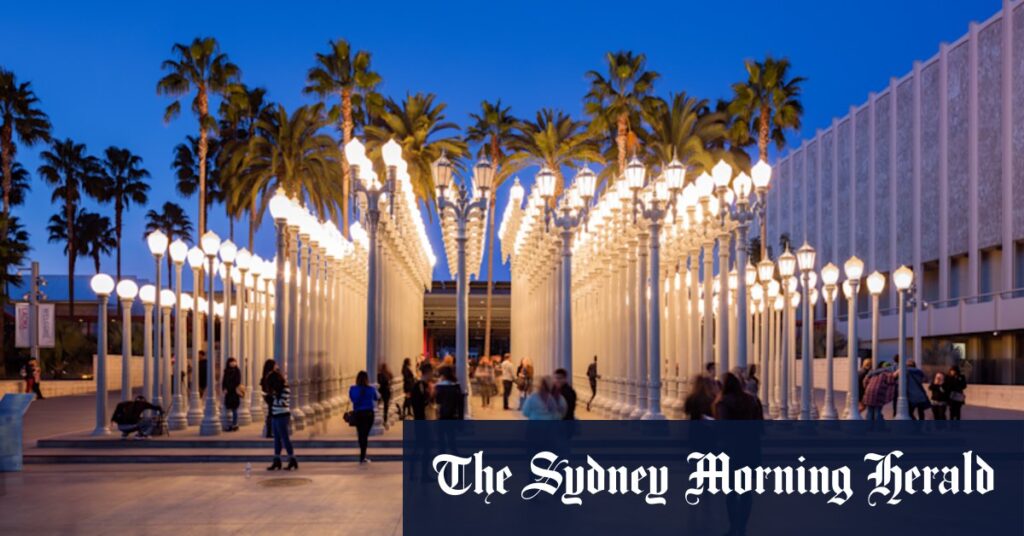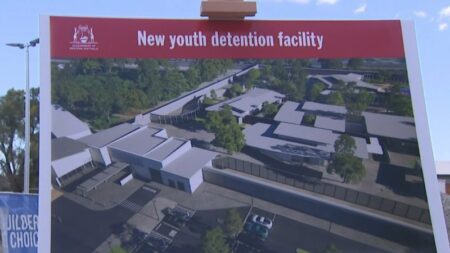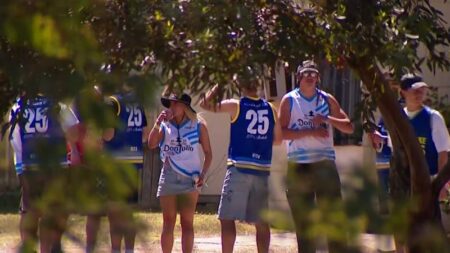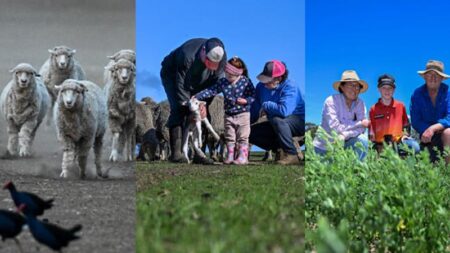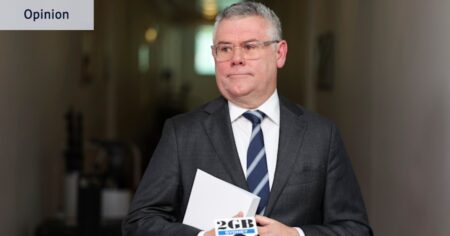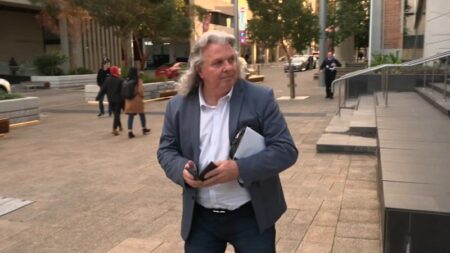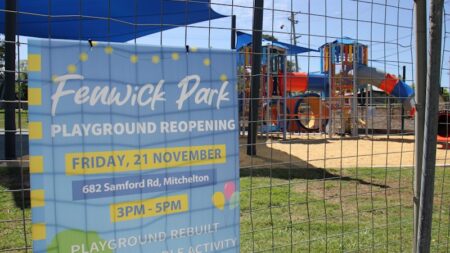Brisbane locals aren’t immune, with more and more direct flights coming on stream between the two cities post-pandemic.
The co-owner of Howard Smith Wharves restaurant Stanley, Louis Tikaram, still visits Los Angeles regularly after an extended stint in the city heading up the kitchen at West Hollywood’s ultra-hip E.P & L.P.
“Growing up, I loved [West Coast] hip-hop, surfing, skating, and LA is the birthplace of those three things … I’m a massive basketball fan,” Tikaram says.
“It was the best place that could possibly exist. Living there, I just never even put it on my list of goals because it just seemed so unobtainable.”
Tikaram wound up living in LA for four years, in the process becoming something of a star of its rapidly diversifying food scene.
“It was changing so fast at the time, and being back there in May, it’s still an exciting place to be, especially for people from our part of the world – they’re two regions that are a match made in heaven, for sure.”
Qantas has for years operated Brisbane-Los Angeles flights seven days a week.
But it’s now addressed the increased demand for access to the city by bringing 787 Dreamliners back to the service after a six-year absence, complementing the A330s that have worked the route since the pandemic.
The Dreamliner doesn’t mean more seats between Brisbane and Los Angeles, but it does mean more premium economy seats – something the faithful old A330s lack. Qantas asked if we wanted to hitch a ride in one for a quickfire trip to Los Angeles. We said, sure.
The flight
Hence I find myself sitting in a Dreamliner on the tarmac at Brisbane Airport on a chilly August night. In a business-class seat, it turns out, so myself and a couple of fellow journalists can hit the ground running on a three-day itinerary put together by Qantas and the Los Angeles Tourism & Convention Board, and then experience the premium economy seats on the way home.
It’s a couple of years since I’ve flown Qantas business, and the last time was on an A330 to Japan. It’s the same 1-2-1 layout with fully flat beds, but the set-up just seems to work better on the Dreamliner, and is a reminder of why I appreciated the redesign when it was first introduced in 2017. I’m on the left side of the aircraft and with the enormous windows on the Dreamliner, the whole set-up really comes into its own. The food is excellent and the service that typically egalitarian, personable Qantas style where nothing is a problem.
Business class on the Qantas 787 Dreamliner.
I notch five hours’ sleep on the 13-hour flight – a record for me – and two of my travel companions get their full eight hours, perhaps due to the Dreamliner’s relatively quiet cabin and ability to maintain a higher air pressure than older aircraft. In recent weeks I’ve also flown business on both Cathay Pacific and Singapore Airlines, and I’d say Qantas is a notch above the former and about par with the latter, although the lack of in-flight Wi-Fi (it’s being rolled out) continues to be a bit of a bummer.
LA in three days
Our digs are the SLS Beverly Hills. We hitch a ride to this Philippe Starck-designed edifice in one of luxury car service BH Rides’ slickly appointed Cadillac SUVs and discover the type of boutique-minded hotel that’s become fashionable in the past decade, full of art and engaging surrealist design flourishes that never get in the way of actually laying your head down and getting some rest. It’s all neutral colours and lush textiles – a beautiful place that feels designed for beautiful people, but nevertheless overflows with the gracious hospitality you associate with the best US hotels.
On the sixth floor of the hotel is an open rooftop with a pool and a restaurant, LADiDa. It’s typical of a boutique brand hotel eatery in the States, in that it can foot it with its independent neighbours outside. We take in the early evening views of the city, its iconic palm trees swaying in the distance, and go large on lobster rolls, pan-seared sea bass, and a seafood tonnerelli pasta.
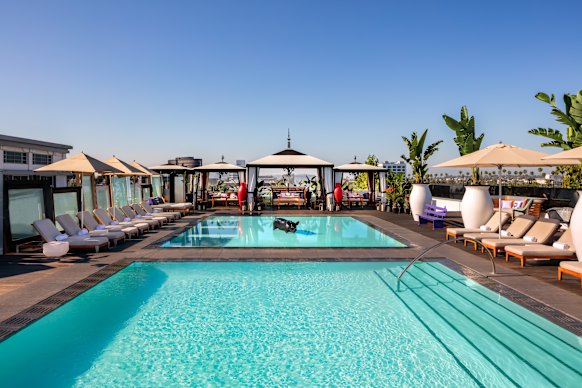
The rooftop at SLS Hotel in Beverly Hills.
Los Angeles, and California in general, finds itself in a weird place right now. The progressively minded city is booming in the lead-up to the 2028 Olympics, while at the same time coming under increasing scrutiny from the country’s hard-right federal government, with Democratic state governor Gavin Newsom becoming one of the most prominent critics of President Donald Trump.
We ask a couple of locals about recent protests against ICE deportations, which triggered Trump to federalise the National Guard – a move later deemed illegal by a federal judge – and they roll their eyes.
“They were protests, mostly peaceful, and contained to a small part of downtown,” one says. “The response was just crazy – entirely out of proportion.”
When we venture out the next day, we discover a buzzy Los Angeles very much not “under siege”. We play a sun-kissed morning game of pickleball atop the glamorous Kimpton La Peer hotel in West Hollywood, its forecourt lined with super cars.
We head to the iconic Original Farmers Market, founded in 1934 – ever heard of “Meet me at Third and Fairfax”? This is that – and it’s buzzing on a Thursday afternoon with locals and tourists shopping for produce, or going large on lunch in the market’s series of interconnected, greenery-lined courtyards.
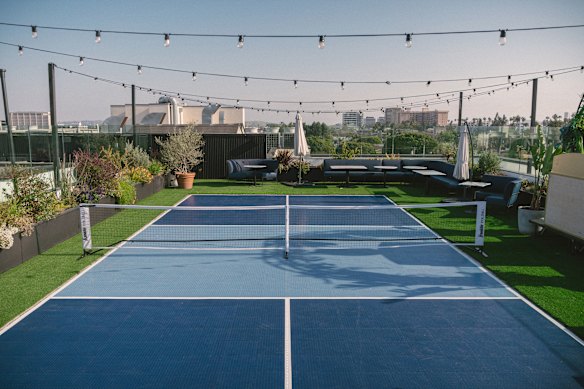
The rooftop pickleball court at the Kimpton La Peer hotel.
Much of it is laid out in charming weatherboard stalls, and there’s a bunch of more curious operators here, such as Scott Kaylin, a New Yorker who made his mark in apparel before moving to the West Coast and lamenting its lack of quality pickles. His answer was Kaylin + Kaylin, which peddles pickles in a stack of varieties. It’s been such a hit he’s now opened a second stall, Topped, which serves a menu of pickle boats. We order a flight; they’re excellent.
The entire trip is filled with these fun food side adventures. We blast through Grand Central Market, founded in 1917, which occupies an old warehouse-style space in the historic Homer Laughlin Building right in the guts of downtown, and eyeball trending eateries such as Miznon, Ghost Sando Shop and Eggslut – all have queues snaking in and around the different stalls with eye-catching neon signage.
I make a beeline for Villa’s Tacos, which has built a reputation for slinging some of the best Mexican street food in the city, earning itself a Michelin Bib Gourmand award in the process. Its signature queso taco is built on a blue tortilla atop fried Monterey Jack cheese and comes stacked with refried beans, onion, guac and coriander. It’s a revelation – in two ways, it turns out: yeah, it’s up there with the very best tacos I’ve eaten, but also a reminder that our own best Mexican restaurants – take Baja in Fortitude Valley, for example – are now not far behind.
We also do Joan’s on Third, an LA institution that, since its inception in 1995, has helped revive Third Street, nearby our hotel. It’s that kind of cafe-deli cross we’re so attuned to in Australia: a light-filled, tiled interior, communal tables, stacks of produce, shelves of cookbooks, and a fast-paced menu of elevated salads and sandwiches.
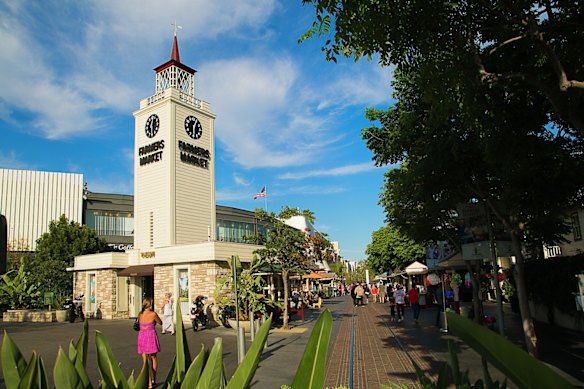
The Original Farmers Market.
Still, this is Los Angeles, so a trip wouldn’t be complete without a few heavy-hitting attractions. It’s just that the heavy-hitters are more diverse these days.
On our second morning we tour SoFi Stadium. This state-of-the-art sports ground sits beneath the flight path into LAX – I spied its sleekly curved roof from the Dreamliner as we completed our final approach – and that accounts for its curious (and expensive – at $5 billion, by far the most expensive in NFL history when completed in 2020) design, which has the playing field buried 100 feet below ground level to help comply with FAA regulations.
Home to both Los Angeles NFL teams, the Rams and the Chargers, the stadium was privately funded by Rams owner Stan Kroenke. And that sunken playing field is just one of its party tricks. Publicity co-ordinator Victoria Germano leads us through the bowels of the complex, through enormous concourse areas and expansive corporate suites decked out with kitchens and banks of flatscreen televisions, and then onto the playing field itself, the surrounding 70,000 seats stacked so steep they could almost tumble down upon you.
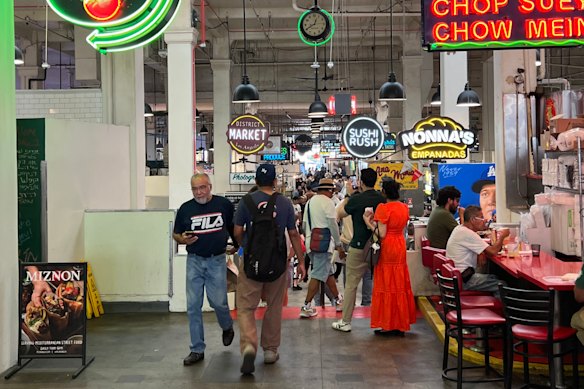
Grand Central Market in downtown Los Angeles.Credit: Matt Shea
The stadium is being prepared for a Rams game the following weekend, but Germano tells us it will also co-host the ’28 Olympics opening ceremony and then be the venue for – wait for it – the Games’ swimming events, with the 100,000-square-foot field converted into the largest natatorium in Olympic history.
If you were fearing Brisbane was maybe behind the eight ball with its own Olympics, SoFi won’t help.
Barely a 10-minute walk from SoFi is Cosm, where we’re to catch a Premier League game between Manchester City and Wolverhampton Wanderers in Wolverhampton. What hardly makes sense on paper is even more bamboozling in person – at least initially – with Cosm’s showpiece an indoor 9600-square-foot fine-pitch LED display dome that wraps around the audience. Imagine a smaller take on Las Vegas’ Sphere and you’re somewhere in the ballpark.
The result, though, is you feel like you’re at the ballpark, or soccer ground, or basketball stadium, whatever it may be. We watch City slice through the Wanderers 4-0 and at times it’s hard to tell where our medium-sized theatre of seats end and the screen begins. Cosm, it turns out, has a decades-long background in building planetariums, which makes a lot of sense, but this is still one of our trip’s true “holy shit” moments.
More old-school but no less impressive is a visit to Dodgers Stadium for a game against the San Diego Padres, with an electric sunset atmosphere buzzing through the stadium given the Dodgers’ recent 2024 run to clinch the World Series. It’s about as essential as Los Angeles gets.
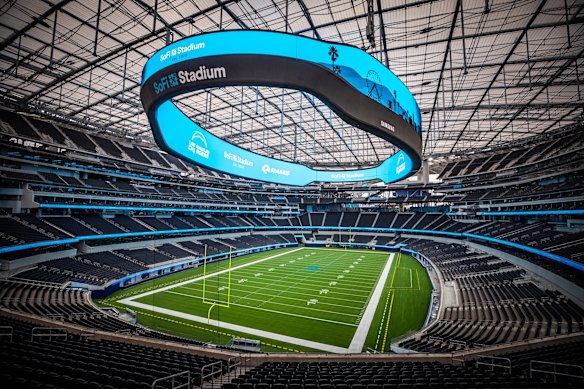
Seen from the inside, SoFi Stadium’s scale is intimidating.Credit: Rich Fury/Getty Images
Before we board our plane back home we take in a pair of LA icons on opposite sides of town. Griffith Observatory, sitting high above the city to the north, remains a must-do, if only to gawk at its copper-domed roof, marble floors and travertine walls, and take in its views of the city below.
It’s a classic LA experience, as is a visit to the Los Angeles County Museum of Art.
But where the former tells of the city’s past, LACMA is all about the future, with the impending opening of a new $720 million gallery. We don’t get to see the (controversial, as these kinds of projects so often are) building but LACMA nevertheless feels like an organisation with a spring in its step, and we take in a bunch of the 150,000 paintings and art objects among its priceless collection. It’s a must-visit for art lovers and helps place Los Angeles’ cultural verve, which is once again clarifying into something distinctively of this city and place.
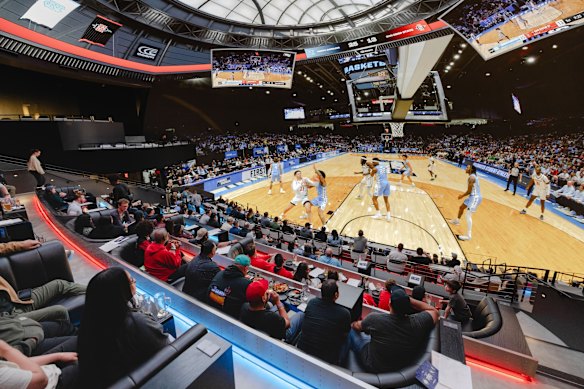
Cosm’s capacity to transport you to a sporting event needs to be experienced to be believed.
Where once it was Jane’s and the Chili Peppers, now it’s Kendrick and SZA and Phoebe Bridgers and Tyler, The Creator. It’s institutions like LACMA but also the independent Institute of Contemporary Art and Kohn Gallery. It’s in the food scene, with classic restaurants such as Musso & Frank and Spago now complemented by a coterie of cutting-edge operations such as downtown’s Kato and Little Tokyo’s Sushi Kaneyoshi, and the stacks of street food options in between.
Heading home
The Dreamliner’s premium economy cabin is a good place to consider all this on my flight back to Brisbane. Don’t get me wrong: it’s more economy than business, but the food and beverage are a definite notch up and the seat is quietly brilliant.
There’s the extra width, sure, but also, when reclined (96.5 centimetres versus 81 centimetres in economy), the seat better supports your lower back – cradle-like is how Qantas describes it, and I tend to agree, although the footrest on the bulkhead in front perhaps doesn’t much suit my 187-centimetre frame. The only recent comparison I can make is to premium economy on Singapore Airlines, and for my needs, at least, Qantas’ current offering beats it.
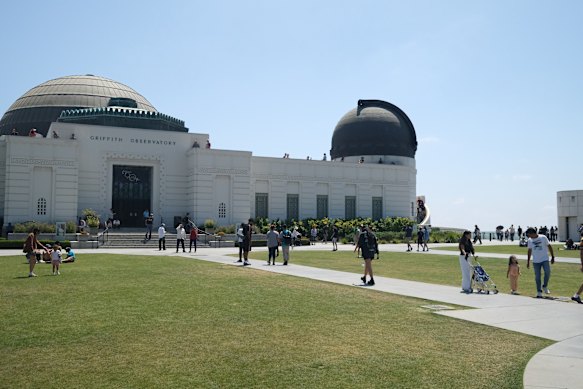
Griffith Observatory remains an LA must-do.Credit: Matt Shea
Someone who has made the Brisbane-Los Angeles jaunt more than most is Ben Johnson, owner of The Falls Farm (which, coincidentally, occasionally supplies Tikaram’s Stanley) but also design firm Josephmark, which established an office in LA when it led a redesign of Myspace in 2012. Once I’m back in Australia, we catch up and discuss what makes the city so special – especially for a Sunshine Coast boy like Johnson.
“We had an opportunity to set up in New York and so I started travelling and spending a bit of time in Los Angeles,” Johnson says. “When Myspace came along, that gave us the opportunity to just go there … New York very much feels like the other side of the world whereas for me, in LA, there was this sort of comfort to it.
“A lot of people go to LA and have a bad experience because they just hit the tourist traps, but there are so many spots once you dig into the fabric of the city.
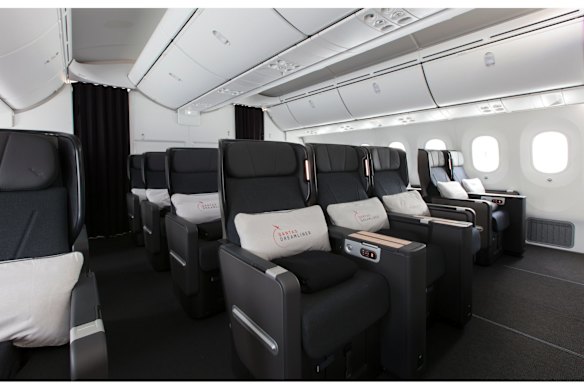
It may not be business class, but Qantas’ clever premium economy seats make it worth the upgrade from the back of the plane.Credit: Qantas
“It was just starting to transform into what it is now, and that was exciting.
“But it has such an outdoor culture, and that reminds me of home. Things stay open late but you can get outdoors in LA year-round; it’s a city where things happen during the day.”
The writer was a guest of Qantas and the Los Angeles Tourism & Convention Board.
Read the full article here


